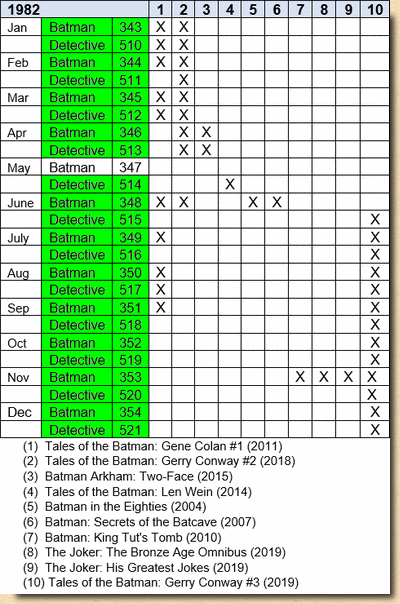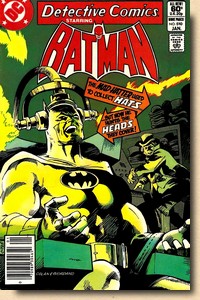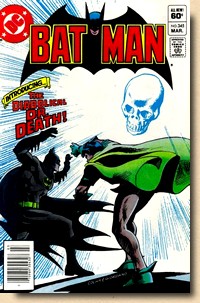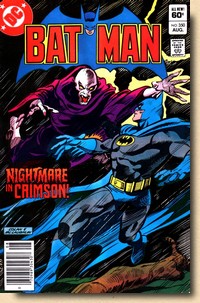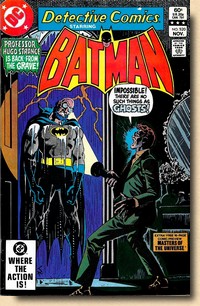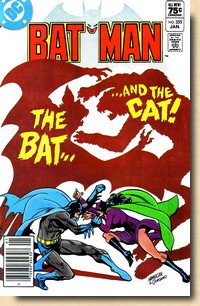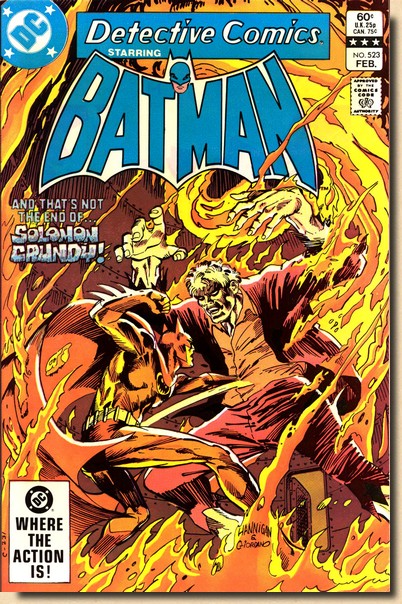 |
 |
A
HAZY SHADE OF BATMAN
AN OVERVIEW OF DC's COLLECTED
EDITIONS OF
BATMAN MATERIAL FROM THE BRONZE AGE (1970-1983)
|
| |
| |
| |
A BRIEF HISTORY OF COLLECTED
EDITIONS
|
| |
| In 1986, DC Comics
published a 336 pages strong and oversize (6.8" x
10.2") anthology paperback titled Superman: The
Greatest Stories Ever Told. Selected by "a
special committee at DC", it contained 18 stories
spanning the years from 1940 to 1986 and was intended to
coincide with the Man of Steel's 50th anniversary. It was a publication format pioneered
back in 1974 by Marvel Comics and their smash hit Origins
of Marvel Comics in collaboration with Simon &
Schuster. Subsequently followed by many themed Marvel
anthologies throughout the 1970s and early 1980s (e.g. Bring
On The Bad Guys, 1976), there was nothing comparable
from DC until that 1986 Superman stories collection.
|
| |
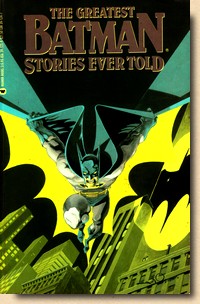
The Greatest
Batman Stories Ever Told (1989)
|
|
The
Superman collection was followed three
years later, in 1989, by an identical
anthology in order to celebrate Batman's
50 years in publication: The Greatest
Batman Stories Ever Told, published
by Warner Books, collected mutiple
stories from 1940 to 1981 on 343 pages.
It was a nice, if somewhat fanciful
collection of Batman stories which, for
the largest part, had not been accessible
to the vast majority of readers and fans
for a while. As such, the trade paperback
collecting reprints was a welcome
treasure trove. But even as DC was
putting out its Superman and Batman
anthologies, Marvel had already
successfully tried out a new reprint
formula: launched in 1986, the Marvel
Masterworks also focused on one
specific superhero (or group of
superheroes) but - rather than being
anthology collections - reprinted their
material in chronological order of
publication, starting out at the very
beginning.
Marvel put
the Mastwerworks series on hold
in 1994, and before continuing them in
1997 (and publishing them to this day),
introduced their Essential Marvel
series in 1996.
|
|
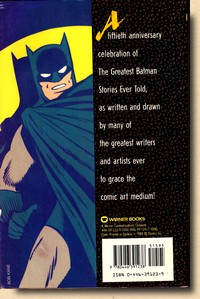
The Greatest
Batman Stories Ever Told (1989)
|
|
|
| |
| Unlike the Masterworks,
which were (and still are) hardcover books printed in
full colour on heavy glossy paper, the Essentials
reprinted classic material in black & white on paper
which was highly reminiscent of the cheap newsprint used
in the 1960s and 1970s. Each volume contained around
20-30 issues of a classic Marvel title in sequential
order, running up to a staggering pagecount of between
450 and 650 pages. |
| |
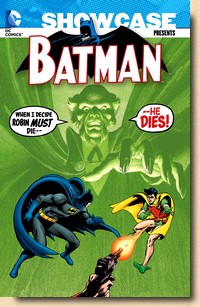
Showcase Presents
Batman #6 (2016)
|
|
Back in 1989, DC had
launched its own version of the
Masterworks concept, calling the series
the DC Archive. Reprinting early
material in (mostly) chronological order,
the Batman got his first volume in 1990,
starting out with his very first
adventures from Detective Comics.
The series was cancelled in 2014, with Batman
Archives #8 being the last
Darknight-themed volume (published in
2012) and only just making it into the
1950s regarding the material reprinted. More ground was
covered in DC's Showcase format,
which followed the formula set out by
Marvel's Essential line and
introduced in 2005. The Batman material
reprinted here in black & white (both
from Detective Comics and Batman)
reached the year 1972 with its sixth
volume in 2016, but it appears that DC
has since discontinued the Showcase
format.
The
point to take away from this little
snippet of comic book reprint publication
history: while Marvel has always been
good at this game, DC has more than once
presented itself as truly struggling with
the task - witness, for example, the by
now third attempt to reprint the Golden
Age (1940s and 1950s) Batman material,
first in the hardcover Archives
series (aborted), then the trade
paperpack Chronicles (aborted),
and now the oversize Omnibus series
(ongoing and into the early mid-1950s,
with volume 9 announced for December
2020).
|
|
|
| |
| For the Darknight
Detective's 80th publication anniversary in 2019, DC's
official publication was yet another anthology
collection: Detective Comics: 80 Years of Batman.
But looking sideways at Marvel's ever-expanding Masterworks
collection, one might wonder how DC has made the classic
Batman Bronze Age period (ranging from 1970 to 1983)
accessible to fans and readers. What follows is the long
and detailed answer, but the short reply would have to
be: DC Comics (still) has no idea how to properly reprint
their classic material, leaving fans with a plethora of
collected series and lots of duplicates while still
having to face missing issues and stories. And: there is
a reason why Marvel excels and DC sucks at reprints. |
| |
| |
DC's
ILLOGICAL ANTHOLOGICAL APPROACH TO COLLECTED
EDITIONS
|
| |
|
| While Marvel Comics (and
other comic book publishers) have fully realized what
their fans and readers really want when it comes down to
reprints - namely to be able to (re-)read a certain
series or a certain hero's adventures in the
chronological order in which they originally appeared -
DC Comics has stubbornly stuck to the anthology format. An anthology is a collection
of (chiefly literary) works chosen by the compiler; the
term traces its origin back to a Classic Greek word
literally meaning "a collection of blossoms".
While this works fine under certain circumstances, a
series of anthologies from a large trove of material
(such as Batman's comic book adventures) will inevitably
produce both duplicates and gaps at the same time: some
"blossoms" will be reprinted time and time
again, while other material will never be selected. For
extensive reprints, it becomes a highly illogical
approach and burdens the reader in more ways than one.
DC Comics initially put out
a fine anthology series centering on specific decades of
Batman stories in the late 1990s and early 2000s, of
which Batman in the Seventies and Batman in
the Eighties cover a nice selection of Bronze Age
material. But when the time came to reprint Batman's
adventures from that period, as featured in Batman
and Detective Comics, in a more comprehensive
way, DC made the awful decision to organize their Batman
collections by creative talent rather than by narrative
continuity.
|
| |
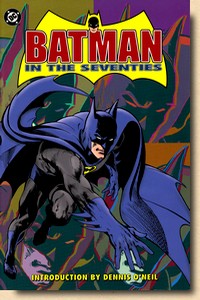
Batman
in the Seventies (2000)
|
|
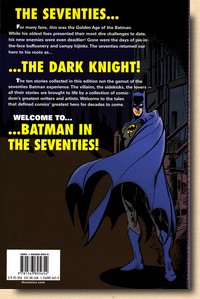
Batman
in the Seventies (2000)
|
|
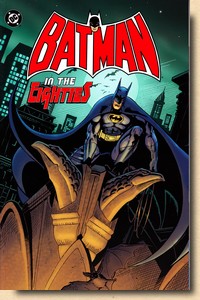
Batman
in the Eighties (2004)
|
|
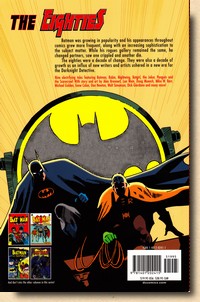
Batman
in the Eighties (2004)
|
|
|
|
| |
| The fundamerntal
shortcoming of this approach is the indifference and lack
of understanding on the part of the publisher that
writers and/or artists frequently changed. The resulting
anthology will therefore only feature the work involving
a certain spotlighted creative talent (e.g. writer A or
artist B), and while that work will be presented in order
of publication, such a reprint volume will not feature an
uninterrupted sequence of issues because writer A or
artist B may have worked on issues #22 and #24 but not
issue #23. This is no problem for stories which are told
and concluded in one issue, but Batman was one of the
first characters where DC followed Marvel's lead with
regard to continuity and on-going plots, which happened
occasionally as of the early 1970s and then extensively
in the early 1980s. The
following overview by year shows the resulting gaps as
well as duplicates and triplicates of DC's anthological
approach, and also illustrates how following storylines
very often involves having to switch from one collected
edition to another.
|
| |

1969
|
| |
| Batman #217
(December 1969, on sale 21 October 1969), written by
Frank Robbins, pencilled by Irv Novick, and sporting a
Neal Adams cover, kicks off the comic book Bronze Age for
Batman, a period characterized by the disbanding of the
Batman & Robin team as Dick Grayson goes to college
and Bruce and Alfred move from Wayne Manor on the
outskirts of town to the Wayne Foundation in Downtown
Gotham. |
| |
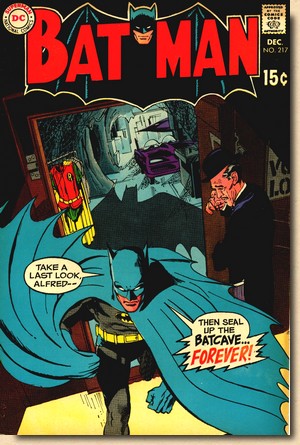
Batman #217
(December 1969)
|
|
It was a drastic move even by
comic book standards. After all, the Batcave had
become a set piece in the perception of Batman as
a popular culture icon, not the least cemented
into place by the frequent views offered to the
millions of people watching the 1960s cult
television series - and the trademark call of "Robin,
to the Batcave!" But then
maybe that was precisley what writer Frank
Robbins had in mind at the time.
"Batmania" was over for good, and by
the end of the 1960s a number of talents at DC
comics had to almost reinvent the Darknight
Detective from scratch in order to pull the
character from the debris of the "camp"
era when the comic books followed the TV series
as closely as they could in order to cash in on
the popularity - which they did, at least for a
while. When the TV show ended, so did the good
times for the Dynamic Duo in their original
medium.
From
this point on,
Batman stories generally start to have a more
"serious" tone, often linked to a “back
to the (darker) roots” transition, leaving
behind the camp humour and sci-fi silliness of
the 1960s for good - and the Batcave
would not be opened up again until Gerry Conway
handed Bruce Wayne and Alfred (and Dick) back the
keys in Batman #348 (June 1982), which
made for an incredible 131 issues (and twelve and
a half years in real time) without the original
Batcave.
This starting point,
Batman #217, was reprinted in 1999 in the
collected edition Batman in the Sixties.
Although out of print, both new and second hand
copies can still be found without major problems;
Batman in the Sixties is also available in
digital form.
|
|
| |
| |

1970
|
|
| |
| DC’s flagship title is
published monthly throughout 1970, whereas Batman
skips the months of April and October, resulting in 10
issues that year (of which two are “Giant Size”
all-reprint issues with 1950s material). It is here that
Dennis O'Neil's starts his iconic run on Batman together
with Neal Adams in Detective Comics #395
(January 1970, on sale 26 November 1969). O'Neil's was looking to make the world of
superheroes feel closer to the real world, moving
characters from spanky clean and sunny surroundings with
intermittent but passing super villain threats to a world
of gritty street level problems which wouldn't go away
even after the super villain was down. O'Neil modernised
Wonder Woman and Green Arrow that way, but when it came
to the Batman, his approach was a markedly different one:
It wasn't so much about updating but rather about
restoration, about peeling off layer upon layer of
primary-colour gloss which had been slapped onto the
character in 30+ years, until the original work of art
became visible again.
Taking up a
cue from writer Bob Haney and artist Neal Adams who had
portrayed Batman in a very sombre way in Brave and the
Bold #79 (August/September 1968) - and which was
quite unlike the regular stories in Batman and Detective
Stories - Denny O'Neil undertook a deliberate effort
to move the Darknight Detective away from the completely
worn out campy vein of the TV series (which ended in
1968) and to once again return the character to his
darker and grittier roots as a mysterious night-time
vigilante:
|
| |
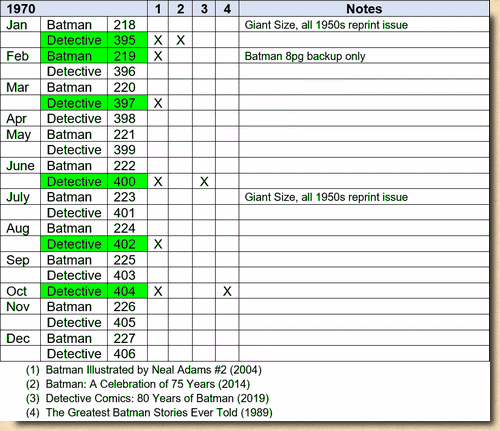
|
|
"I
went to the DC library and read some of the
early stories. I tried to get a sense of what
Kane and Finger were after."
(O'Neil in: Pearson & Uricchio 1991)
This
take on the Batman by Dennis O'Neil was perfectly
reflected by the artwork of Neil Adams, and it
would resound for decades and leave an indelible
mark not only on the character but indeed comic
book history.
"We
went back to a grimmer, darker Batman, and I
think that's why these stories did so well
(...) Even today we're still using Neal's
Batman with the long flowing cape and the
pointy ears." (Giordano in:
Daniels, 1999)
Maybe that's why
only Batman stories from 1970 which were drawn by
Neal Adams have been reprinted in collected
editions so far (not surprisingly, Batman
Illustrated by Neal Adams #2, published in
2004, contains all of them).
|
|
| |
| The result of an approach
which reprints issues according to creative talent (in
this case Neal Adams) in an anthology format can clearly
be seen: no less than 14 of the year's total of 20 issues
of Batman and Detective Comics (not
counting the reprint Giant Size issues) have not been
reprinted by DC so far. |
| |
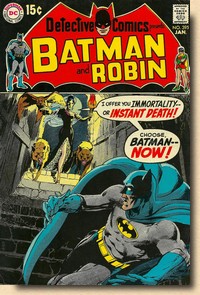
Detective
Comics #395
|
|
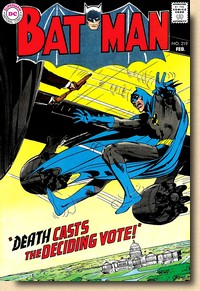
Batman
#219
|
|
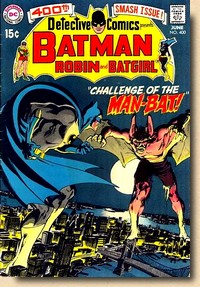
Detective
Comics #400
|
|
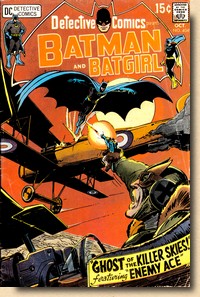
Detective
Comics #404
|
|
|
|
| |
| |

1971
|
|
| |
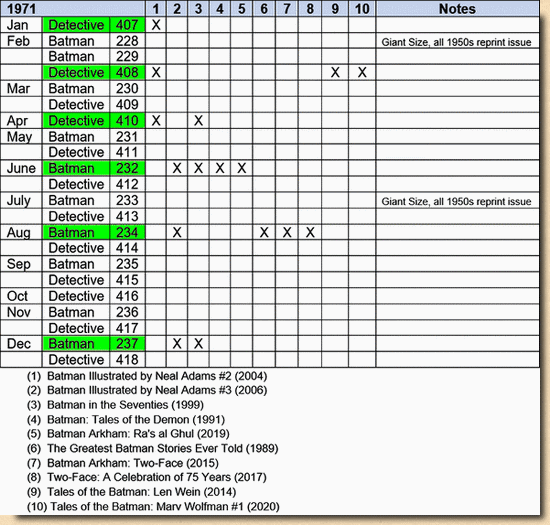
|
|
Detective
Comics is published monthly throughout 1971,
whereas Batman skips the months of April
and October, resulting in 10 issues that year (of
which two are “Giant Size” all-reprint issues
featuring material from the 1950s). Again, as with the previous
year, the reprinted material from 1971 to this
date only includes Batman stories drawn by Neal
Adams - all of which are featured in Batman
Illustrated by Neal Adams #2.
And another result
of the anthology approach becomes apparent here
as well: the “cumulative reprinting” of
certain key issues, illustrated by the
introduction of Ra’s al Ghul in Batman
#232 and a pivotal Two Face appearance in Batman
#234, both of which are reprinted in no less than
four different collected editions each.
So while 1971 Batman
material has been reprinted in no less than 10
different collected editions between 1989 and
2020, there still is a total of 14 (not counting
the reprint Giant Sizes) issues of Detective
Comics and Batman from 1971 which
are not accessible through collected editions to
this day.
|
|
| |
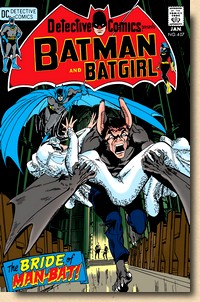
Detective
Comics #407
|
|
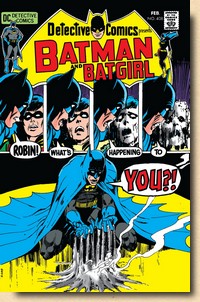
Detective
Comics #408
|
|
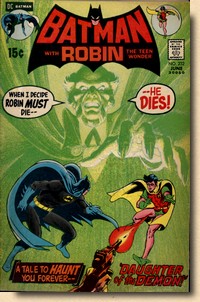
Batman
#232
|
|
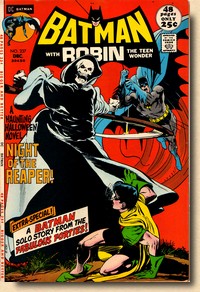
Batman
#237
|
|
|
|
| |
| |

1972
|
|
| |
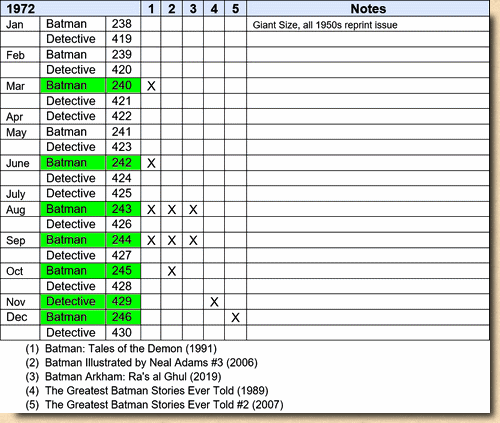
|
|
Detective
Comics is published monthly throughout 1972,
whereas Batman changes its publication
schedule in mid-year and now skips a total of
four months, namely January, March, July and
November. For the year 1972, however, this still
results in a total of 10 issues of Batman. This is the first year of
Batman’s Bronze Age period which has material
reprinted in collected editions which did not
involve the artwork of Neal Adams.
While this does
reflect a broader approach with regard to
creative talent (certainly a good thing for
fans), it does, however, also clearly show the
shape of complications to come - which is
reflected in the fact that no less than four
different collected editions are needed to access
the seven reprints from 1972.
This contrasts
sharply with the fact that no less than 12 (not
counting the one Giant Size) issues of Detective
Comics and Batman from 1972 have
not been reprinted to this day.
|
|
| |
| And again, the “cumulative
reprinting” which is so typical of multiple anthologies
on one subject, is in evidence, with Batman #243
and #244 reprinted in no less than three different
collected editions. |
| |
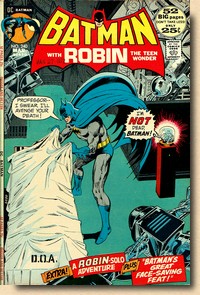
Batman
#240
|
|
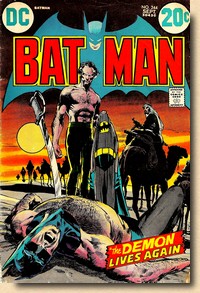
Batman
#244
|
|
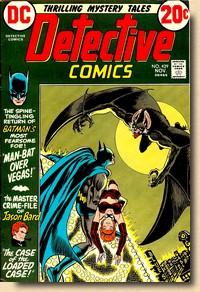
Detective
Comics #429
|
|
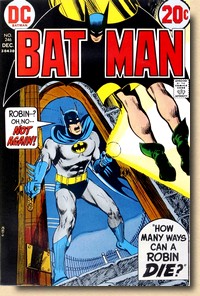
Batman
#246
|
|
|
|
| |
| |

1973
|
|
| |
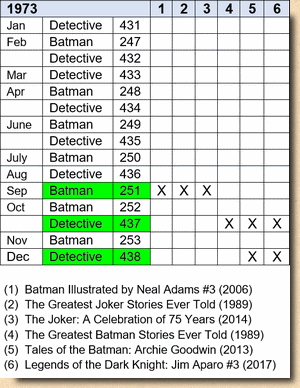
|
|
Detective
Comics is published monthly up until the
April 1973 issue, then skips a month and
continues as a bi-monthly title, resulting in a
total of 9 issues in 1973; as of the
December/January 1973/74 issue, Detective
Comics also changes to the 100 pages
"Super Spectacular" format (adding lots
of non-Batman material, some of it reprints). Batman is published
monthly with the exception of January, March,
July and November, resulting in a total of 8
issues of Batman in 1973.
The chart for 1973
really says it all - and paints a clear picture
of the incongruity of DC's approach to Brone Age
reprints. While there are no less than 6
different collected editions (published between
1989 and 2017) featuring material from 1973, only
a mere three issues have actually ever been
reprinted - and to read them you will need at
least two different collected editions. Which
also means that two of these issues have been
reprinted three times and one of them twice - and
that fans and collectors are more than likely to
end up with the same reprinted issue in more than
one collected edition on their bookshelf.
All in all, one
might be hard pressed to find a better example
than the year 1973 to illustrate, in a nutshell,
the absurdity of the anthological approach to
Batman reprints.
|
|
| |
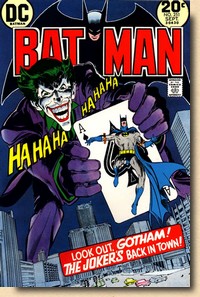
Batman
#251
|
|
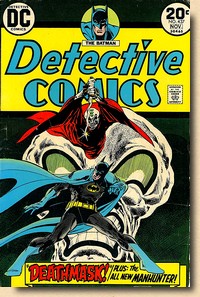
Detective
Comics #437
|
|
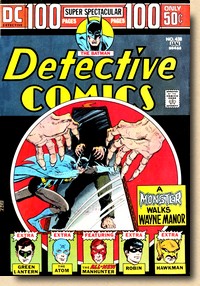
Batman
#240
|
|
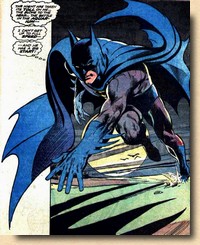
Iconic
Batman posture by Neal Adams from
Batman #251 - one of
only three titles from DC's 1973
slim reprint pickings
|
|
|
|
| |
| |

1974
|
|
| |
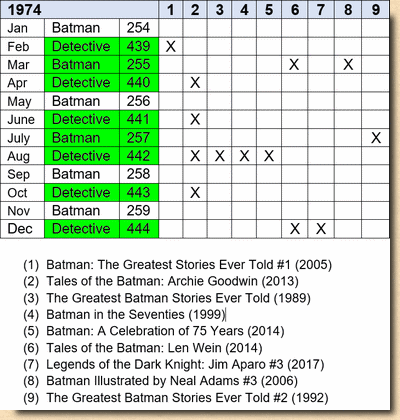
|
|
Detective
Comics is published bi-monthly throughout
1974, as is Batman. As the annual number of
issues decreases to a total of 12, the percentage
of those reprinted in collected editions goes up
to two thirds. However, no less than 5 collected
editions are required in order to read those 8
reprinted Batman features; it starts to get
complicated, and DC’s lack of coherence in its
reprint policy is begining to ask a lot from
fans.
In order to read the
reprinted material in chronological order, one
first needs to turn to Batman: The Greatest
Stories Ever Told #1 (2005) for one issue,
then switch to either Tales of the Batman:
Len Wein (2014) or Batman Illustrated by
Neal Adams #3 (2006) for another issue,
before switching to Tales of the Batman:
Archie Goodwin (2013) - at least this
collected edition provides two consecutive issues
(Detective Comics #440 and #441). After
that, yet another different volume needs to come
down from the bookshelf: The Greatest Batman
Stories Ever Told #2 is from 1992
and a sequel to the first collected edition from
1989, not the confusingly similarly titled Batman:
The Greatest Stories Ever Told #1 from 2005.
|
|
| |
| Confusingly similar titles
are, however, the least of worries for anyone wishing to
read the 1974 reprints in chronological order, because The
Greatest Batman Stories Ever Told #2 (1992)
only offers one issue. For the next one - Detective
Comics #442 - there are no less than 4 different
collected editions to chose from, although sticking with Tales
of the Batman: Archie Goodwin (2013) is the best
option as this volume also reprints the next issue: Detective
Comics #443. For Detective Comics #444,
however, yet another switch is necessary - most likely to
Tales of the Batman: Len Wein (2014) which was
already in play earlier, although it is also reprinted in
Legends of the Dark Knight: Jim Aparo #3 (2017). Again, the absurdity of the
anthological approach pursued by DC for the Bronze Age
Batman material becomes painfully evident - painful also
because although the reprinted material is far from
complete one needs to acquire at least 5 separate
collected editions in order to be able to read those 8
reprinted main Batman features.
|
| |
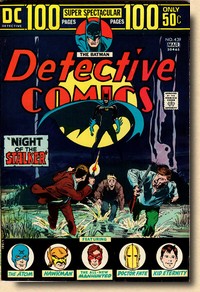
Detective
Comics #439
|
|
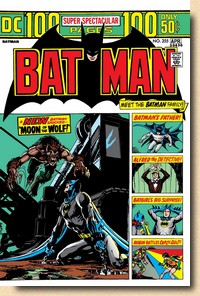
Batman
#255
|
|
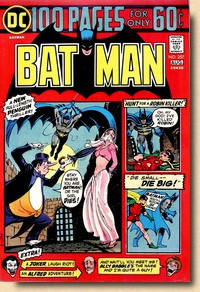
Batman
#257
|
|
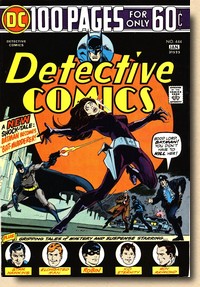
Detective
Comics #444
|
|
|
|
| |
| |

1975
|
|
| |
| Detective Comics
and Batman are both published bi-monthly until
the April 1975 cover date, at which point both titles
revert to a monthly publication schedule (Batman
#261 is cover dated March/April, Batman #262
carries a cover date of April). This change is
accompanied by reverting both titles from their 68-page
“Giant” format back to regular comic book format as
of Batman #263 and Detective Comics
#446 (which also spells the end for reprints of short
Batman stories from both titles from the 1940s, 1950s and
1960s in order to fill those 100 pages). |
| |
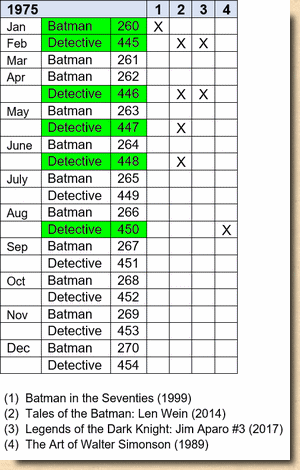
|
|
Of the
total 21 issues across both titles, however, a
mere 6 have been reprinted in collected editions
by mid-2019, a fact once again entirely due to DC’s
decision to organize their Batman collections by
creative talent rather than by narrative
continuity: Whilst writer Len Wein and artist Jim
Aparo are covered, most Batman features in both
titles during 1975 were penned and pencilled by
others (most notably writer David Vern and
artists Ernie Chan), but as their work has not
(yet) been collected, fans wanting to read up on
those talents’ lengthy runs will need to turn
to the original comic books. DC has announced a
collected edition with Batman work by José Luis
García-López for late 2020, which then might
reprint Detective Comics #454.
| |
|
|
|
|
| |
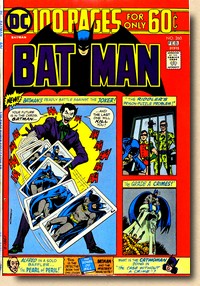
Batman #260
|
|
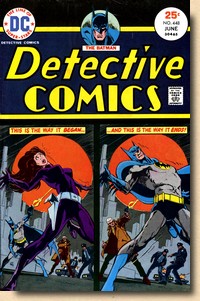
Detective Comics #448
|
|
|
|
| |
| |

1976
|
|
| |
| Detective Comics
and Batman are both published monthly throughout
1976, but although this was a year of fun issues with
many done-in-one and some done-in-two storylines (as well
as being the year when barcodes starting appearing on
covers and Detective Comics went through no less
than two title logo changes), 1976 is at the current
moment (2020) almost non-existent in DC’s collected
editions. |
| |
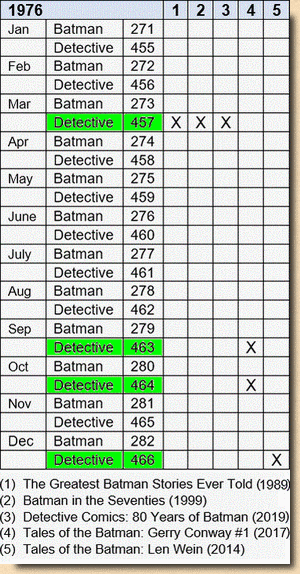
|
|
Once
again, this is entirely due to the fact that DC
structures and organizes its reprints, for the
most part, by artist rather than by narrative
continuity, although Detective Comics
#457 (reprinted in no less than three different
collected editions) with its classic Dennis O’Neil
story “There is no Hope in Crime Alley!”,
penciled by Dick Giordano, doesn't fit that
formula - neither O'Neil nor Giordano have had
their Batman work featured in an anthology volume
so far. Only
three other issues of Detective Comics from
1976 have been reprinted to this date (with no Batman
issue at all), making this possibly one of the
most frustrating years for Bronze Age Batman
fans, even more so than 1975. It is this period
in the publication history of Batman which really
shows how badly DC is handling its collected
editions and reprint material.
| |
|
|
|
|
| |
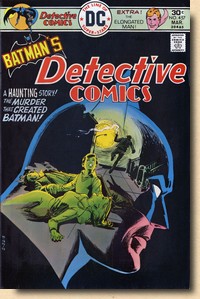
Detective Comics #457
|
|
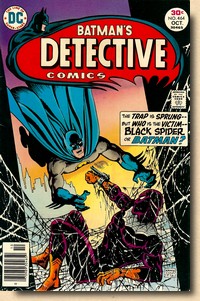
Detective Comics #464
|
|
|
|
| |
| |

1977
|
|
| |
| Batman is
published monthly, while Detective Comics goes
back to a publication schedule of being bi-monthly until
the May 1977 cover date when the publication schedule is
changed to 8 issues a year, i.e. “monthly with the
exception of January, April, July and October” (as
labelled by DC). Of
the total 20 issues of Batman and Detective
Comics published in 1977, 11 have been reprinted.
Some only feature in one collected edition (e.g. Detective
Comics #468 or Batman #293) while others,
once again, have been almost reprinted to death. Case in
point for 1977 is Detective Comics #474, the
second appearance of Deadshot (after he previously
appeared in Batman #59, June-July 1950) and
published in no less than 5 reprint collections between
1988 and 2019.
|
| |
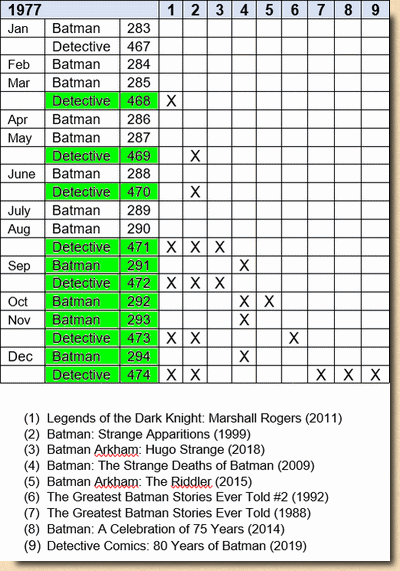
|
|
DC’s
policy of organizing collected editions by artist
rather than by narrative continuity provides an
especially irksome situation where the Batman
feature of Detective Comics
#468 is
reprinted in Legends of the Dark Knight:
Marshall Rogers (2011) but without its cover
– which was drawn by Jim Aparo and is hence
reprinted, on its own, in Legends of the Dark
Knight: Jim Aparo #3 (2017). It hardly gets any worse, but
unfortunately this is not the only example of an
editorial policy which does not only not care for
continuity or integrity of the material
reprinted, but simply doesn't seem to care at
all; there's no less than 30 issues of Batman
not reprinted between issues #260 (original
cover date January 1975) and #291 (September
1977) to date.
| |
|
|
|
|
| |
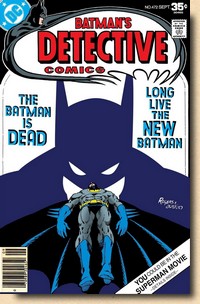
Detective Comics #472
|
|
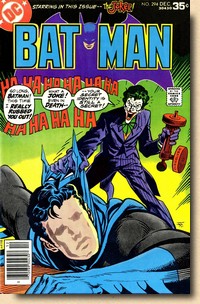
Batman #294
|
|
|
|
| |
| |

1978
|
|
| |
| Batman is still
published monthly, while Detective Comics starts
out as monthly with the exception of January, April, July
and October (i.e. eight issues a year) but then reverts
to bi-monthly as of Detective Comics #476
(March/April cover date). |
| |
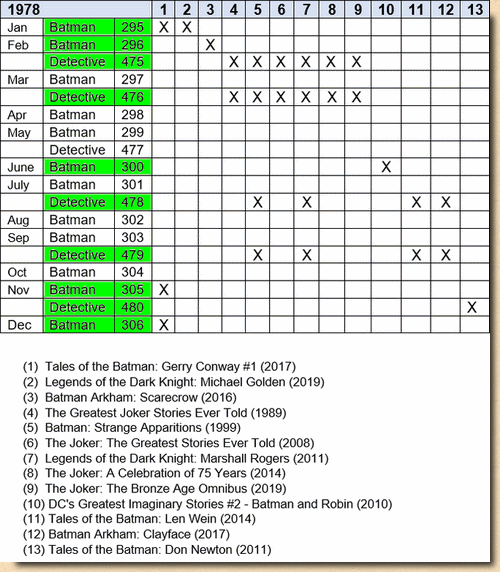
|
|
At this
point, things get even more complicated: The main
Batman feature (17 pages) of Batman #303
is not collected, but the “Unsolved Cases of
the Batman” back-up feature (8 pages) is (in
the 2019 Legends of the Dark Knight: Michael
Golden). The table shown here, however, only
lists collected main features of the two Batman
titles, and for 1978 there are no less than 13 -
yes, thirteen - collected editions. This is due
to the by now all too familiar phenomenon of a
few issues being reprinted multiple times, such
as Detective Comics issues #475 and
#476, which are reprinted in no less than 6 -
yes, six - different collected editions. 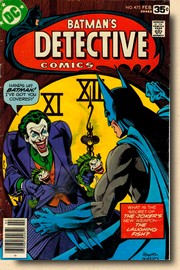 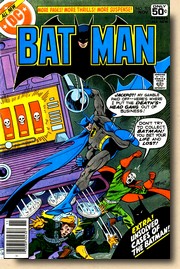
Detective Comics #475
/ Batman #305
|
|
| |
| |

1979
|
|
| |
| 1979 is the first year for
which DC’s collected editions provide a comprehensive
and almost entirely complete reprinting – and most of
it in just two volumes, thanks to a stable roster of
writers and artists. |
| |
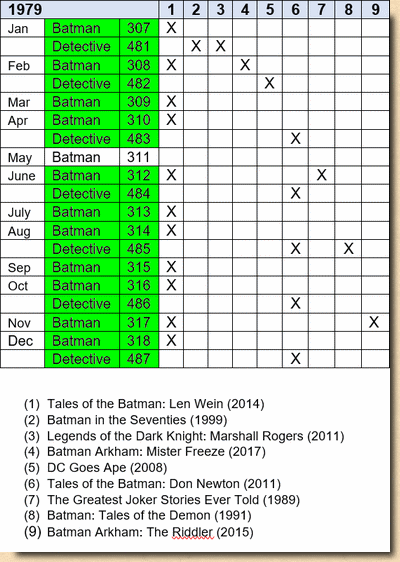
|
|
While Batman
is still published monthly, Detective Comics
continues to be published bi-monthly but, because
it is merged with the previously ongoing Batman
Family title, becomes a “Dollar Comic”
with 68 pages as of issue #481. Due to this
merging of titles, the cover dates become a bit
confusing; even though Detective Comics
#480 had a “November/December 1978” cover
date, the new "Dollar Comics" Detective
Comics #481 has a “December/January 1979”
cover date. The
Batman run is almost complete (missing
only issue #311) in Tales of the Batman: Len
Wein (2014), while Detective Comics
#483 through 487 are all reprinted in Legends
of the Dark Knight: Marshall Rogers (2011),
missing only the first two issues of 1979 (both
of which are featured in two other collected
editions).
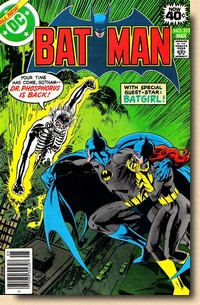 |
|
The
one that (almost) got away from DC's 1979
collected editions: Batman #311,
written by Steve Englehart and pencilled
by Irv Novick with inks by Frank
McLaughlin. It will be featured
in a new collected edition, Tales of
the Batman: Steve Englehart,
announced by DC for publication in 2020.

|
|
|
| |
| |

1980
|
|
| |
| 1980, just as the previous
year, has a comparatively good coverage: of the 22 total
issues of Batman and Detective Comics,
only three have not been reprinted to this date. |
| |
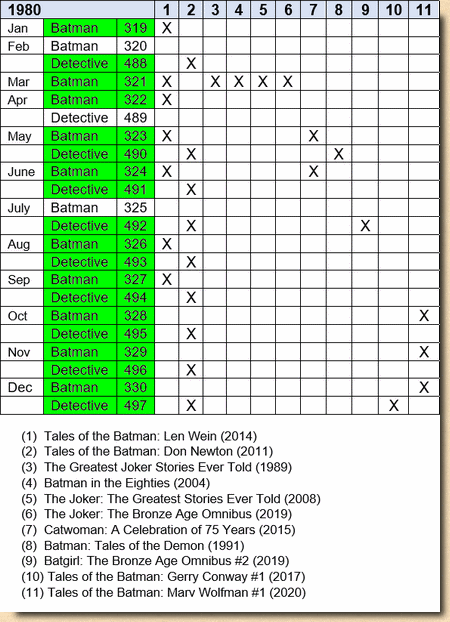
|
|
Batman
is still published monthly, whereas Detective
Comics continues to be published bi-monthly
up until the April 1980 cover date issue, from
which point on it too regains its monthly
publication status, while retaining its “Dollar
Comic” format with 68 pages until the November
1980 issue when the format reverts back to the
standard 36 page count. Once again, however, the
proliferation of collected editions is
staggering, with no less than eleven publications
(ranging from 1989 to 2020) featuring reprints
from 1980. Luckily for the fan, Tales of the
Batman: Don Newton (2011) includes almost
all issues of Detective Comics, while
most of the Batman issues can be found
in Tales of the Batman: Len Wein (2014),
complemented by reprints featured in Tales of
the Batman: Marv Wolfman #1 (2020).
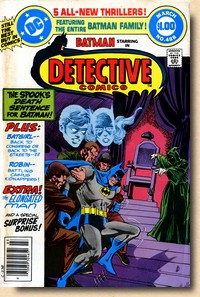
Detective Comics #488
|
|
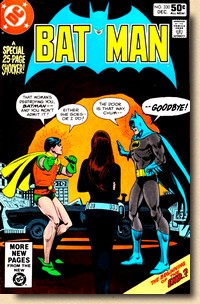
Batman #330
|
|
|
| |
| |

1981
|
|
| |
| Both Batman and Detective
Comics are published monthly throughout 1981, and it
is the third year in a row enjoying almost complete
coverage in DC's various collected editions, with only
one single issue missing (Batman #336). |
| |
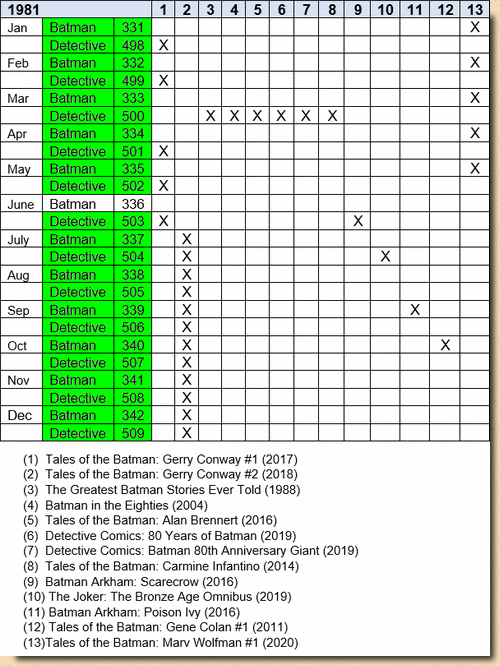
|
|
However,
the material from a total of 23 issues of Detective
Comics and Batman is scattered
throughout no less than 13 collected editions
published between 1988 and 2020, and the results
of this haphazard approach to structuring reprint
material is illustrated in an exemplary way by Detective
Comics #500. That anniversary issue
contains, amongst other features, two main Batman
stories, but while “To kill a Legend” is
reprinted in no less than 5 collected editions (Greatest
Batman Stories Ever Told, 1988; Batman
in the Eighties, 2004; Tales of the
Batman: Alan Brennert, 2016; Detective
Comics: 80 Years of Batman, 2019; Detective
Comics: Batman 80th Anniversary Giant,
2019), “What happens when a Batman dies?” is
reprinted only in one (Tales of the Batman:
Carmine Infantino (2014).
Three collected
editions provide the bulk of the 1981 material,
but a minimum of four separate collections is
required for continuous reading.
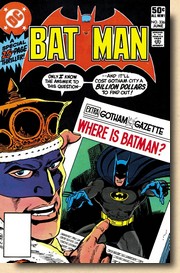 Batman #336 Batman #336
|
|
The
one that got away from DC's 1981
collected editions: Batman #336,
plotted by Bob Rozakis, written by Roy
Thomas and pencilled by José Luis
García-López (with inks by Frank
McLaughlin). DC has announced a
collected edition with Batman work by
José Luis García-López for late 2020
which is also to include Batman
#336.
|
|
|
| |
| |

1982
|
|
| |
| Both Batman and Detective
Comics are published monthly throughout 1982, and
that year serves as yet another excellent example to
illustrate the shortcomings of DC’s approach to
collected editions. |
| |
Initially
focusing on artist rather than writers,
the Tales of the Batman
collected editions contained numerous
ruptures of continuous storylines because
even though Gerry Conway wrote almost all
1982 issues of Batman and Detective
Comics, artists Gene Colan and Don
Newton took turns to cover the workload
of both titles (which carried a storyline
which continued over between the two
titles almost all throughout 1982).
"This
type of collection, organized by
artist rather than by narrative
continuity, makes for occasionally
frustrating reading, despite the
pleasures of the individual issues.
There are issues of Batman and
Detective Comics not present here
(i.e. not penciled by Colan) that
flesh out the vampire arc. As
presented here, it is full of holes,
and the conclusion is sudden."
(Burchby, 2011)
|
|
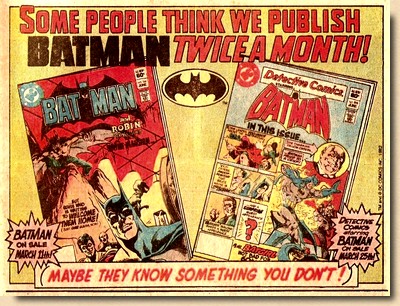
In-house ad from Detective
Comics #515
|
|
|
| |
| These are problems which
would never have occured had the issues been reprinted in
simple chronological order - and the situation was a
truly miserable affair until DC turned to featuring writers in
the Tales of the Batman collected editions; Tales
of the Batman: Gerry Conway #2 and #3 (published in
2018 and 2020) finally fixed the Batman year 1982 - except for Batman
#347. Don't hold your breath for a reprint of that
standalone story issue, though, as it was penned by
"guest writer" Robin Snyder and pencilled by
"guest artist" Trevor Von Eeden. Also noticeable -
once again - is the proliferation of reprint
publications: there's no less than ten, and two issues (Batman #348 and Batman #353) are
reprinted not twice, not thrice, but four times.
|
| |
|
| |
| |

1983
|
|
| |
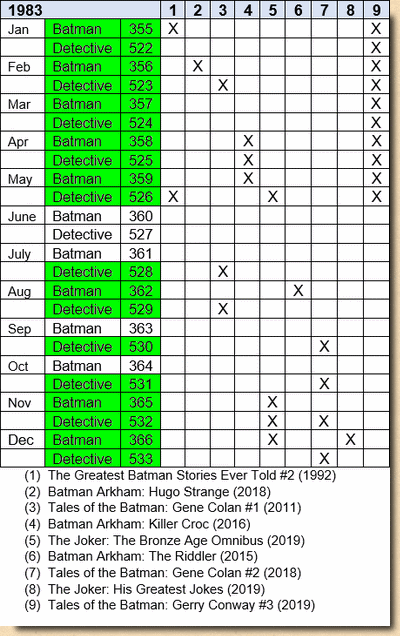
|
|
Both Batman
and Detective Comics are published
monthly throughout 1983, the year commonly
defined as the last twelve months of the Bronze
Age period of comic books. The reprinted material from
1983 is a motley collection spread out over no
more than nine collected editions, yet still
leaves out one fifth of that year’s issues –
a problem which will not be cured until DC
publishes a volume of Doug Moench’s work, who
took over the scripting reigns from Gerry Conway
mid-year.

|
|
| |
|
| |
| When it comes to collected
editions of reprint material featuring the Batman
post-Golden Age (i.e. after 1956), DC Comics took a wrong
turn and just kept going. |
| |
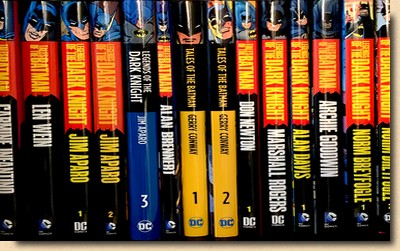
|
|
A simple look at the
bookshelf of someone who owns a few of these
collected editions will already provide a first
hint, as just the backs of these hardcovers
display anything but coherence - quite unlike
rival Marvel (who of course excels at the game of
reprints), who managed to more or less maintain a
uniform look of their Masterworks over
the past twenty years. The problem
started when DC decided - after previously
structuring reprints by a theme, such as
"Batman in the Seventies" or stories
featuring a specific villain - to publish
collected editions which focused on artists.
What, one wonders,
was DC thinking? That readers would enjoy the
artwork so much that they wouldn't really care
about the story?
|
|
| |
| Clearly,
collected editions focused on artists are inherently flawed, as pencillers
working continuously on a specific title were not the
norm at DC during the Bronze Age (and neither were they
over at Marvel, with a few exceptions, such as Gene
Colan's run on the entire 70 issues of Tomb of Dracula). So while e.g. the two volumes of
Colan's Batman artwork from 1981-1983 are nice, they
present the reader with far too many gaps and holes in
ongoing stories to be truly enjoyable. They are,
essentially, useless, and once DC started to publish the
Batman Bronze Age material structured by writers, they
became obsolete. The switch to author-based collected
editions has improved things greatly for the second half
of the Bronze Age, but especially the early 1970s remain
in a sad state, with quite a few good Batman stories
waiting to be told again. It is unlikely that DC will ever
backtrack and start a Bronze Age reprint collection of
Batman material in chronological order (as they have done
with the Brave and the Bold material) - and if
they did, many fans would be faced with the decision of
whether or not to buy material they already own,
scattered across a plethora of volumes of collected
editions (as with the Brave and the Bold
material).
It's almost as though the
Joker is running the reprints editorial board straight
out of Arkham - and the joke is squarely on the readers,
the collectors, the fans.
|
| |
| BIBLIOGRAPHY BURCHBY Casey (2011) "Review: Tales of the Batman – Gene
Colan, Volume One",
in The Comics Journal, 28 October 2011
DANIELS Les
(1999) Batman: The Complete History, Chronicle
Books
PEARSON
Roberta E. & William Uricchio (1991) "Notes from
the Batcave: An Interview with Dennis O'Neil", in The
Many Lives of the Batman: Critical Approaches to a
Superhero and His Media, Routledge
|
| |
| |
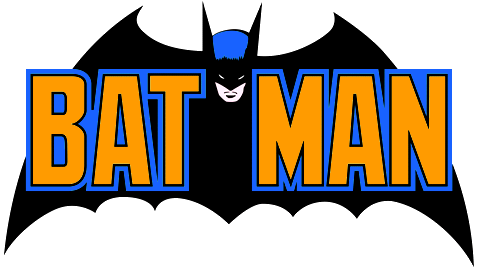
BATMAN
and all related elements are the property of DC Comics,
Inc. TM and © DC Comics, Inc., a subsidiary of Time
Warner Inc.
The illustrations presented here
are copyright material. Their reproduction for the
review and research purposes of this website is
considered fair use as set out by the Copyright Act
of 1976, 17 U.S.C. par. 107.

(c) 2020
uploaded to the web 1 June
2020
|
| |

























































